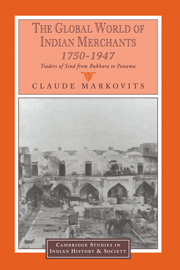Book contents
- Frontmatter
- Contents
- List of maps
- List of tables
- Acknowledgements
- Glossary
- Introduction
- 1 South Asian merchant networks
- 2 The regional context: Sind economy and society, c. 1750–1950
- 3 The Gate of Khorrassan: the Shikarpuri network, c. 1750–1947
- 4 From Kobe to Panama: the Sindworkies of Hyderabad
- 5 Patterns of circulation and business organization in two merchant networks
- 6 The business of the Sind merchants
- 7 The politics of merchant networks
- 8 Community and gender in two merchant networks
- 9 Epilogue: the Sindhi diaspora after 1947
- Conclusion
- Appendices
- Bibliography
- Index
4 - From Kobe to Panama: the Sindworkies of Hyderabad
Published online by Cambridge University Press: 22 October 2009
- Frontmatter
- Contents
- List of maps
- List of tables
- Acknowledgements
- Glossary
- Introduction
- 1 South Asian merchant networks
- 2 The regional context: Sind economy and society, c. 1750–1950
- 3 The Gate of Khorrassan: the Shikarpuri network, c. 1750–1947
- 4 From Kobe to Panama: the Sindworkies of Hyderabad
- 5 Patterns of circulation and business organization in two merchant networks
- 6 The business of the Sind merchants
- 7 The politics of merchant networks
- 8 Community and gender in two merchant networks
- 9 Epilogue: the Sindhi diaspora after 1947
- Conclusion
- Appendices
- Bibliography
- Index
Summary
While the Shikarpuri network developed during the second half of the eighteenth century in relation to the caravan trade of Central Asia at the time of the expansion of the Durrani Empire, an international trading network developed in the second half of the nineteenth century in another of the main towns of Sind, Hyderabad, in relation to international maritime trade and within a context which was colonial. As a result of its reliance upon the new technologies of the steamship and the electric telegraph, the network built after 1860 by the Hyderabadi merchants known as Sindwork merchants or Sindworkies came, by the late nineteenth century, to encompass most of the colonial and semi-colonial world. The origins of the network, as in the case of Shikarpur, are somewhat obscure, but an analysis of the socioeconomic context of post-annexation Hyderabad can provide some clues.
The context: Hyderabad in the post-annexation era
By the time Sir Charles Napier defeated the Talpur army at the battle of Miani and proceeded to the annexation of Sind to British India, Hyderabad, a recent urban foundation of the Kalhoras, had been for sixty years the seat of the court of the main branch of the reigning Talpur dynasty of Sind. It was a town of some 20,000 inhabitants, described as unprepossessing by most contemporary travellers, except for its imposing fortress and the tombs of the Mirs situated in the immediate vicinity.
- Type
- Chapter
- Information
- The Global World of Indian Merchants, 1750–1947Traders of Sind from Bukhara to Panama, pp. 110 - 155Publisher: Cambridge University PressPrint publication year: 2000



